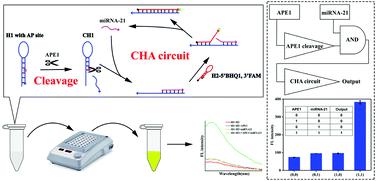Our official English website, www.x-mol.net, welcomes your
feedback! (Note: you will need to create a separate account there.)
A dual-functional fluorescent biosensor based on enzyme-involved catalytic hairpin assembly for the detection of APE1 and miRNA-21
Analyst ( IF 3.6 ) Pub Date : 2022-04-19 , DOI: 10.1039/d2an00108j Xiaoyong Lu 1 , Dan Li 2 , Zewei Luo 2 , Yixiang Duan 1
Analyst ( IF 3.6 ) Pub Date : 2022-04-19 , DOI: 10.1039/d2an00108j Xiaoyong Lu 1 , Dan Li 2 , Zewei Luo 2 , Yixiang Duan 1
Affiliation

|
Both apurinic/apyrimidinic endonuclease 1 (APE1) and microRNA-21 (miRNA-21) have been reported to be related to tumors, enabling them to be the biomarkers of several cancers. This has led to the development of various biosensors to detect APE1 or miRNA-21. However, biosensors that focus on single target detection are subject to low accuracy. In this work, a fluorescent biosensor based on enzyme-involved catalytic hairpin assembly (CHA) for the detection of APE1 and miRNA-21 was developed, aimed at improving the accuracy of early-phase diagnosis of cancers. Two hairpin structured DNA probes (H1 and H2) were utilized to concatenate the enzyme-assisted circuit and CHA circuit in the system. The stem of H1 with a blunt end was modified with an AP site, while H2 was modified with 6-FAM at the 5′ terminal and Dabcyl at the 3′ terminal. In the presence of APE1, H1 was cleaved from the AP site to expose the toehold sequence. Then, miRNA-21 bound with the toehold sequence to initiate the CHA reaction between H1 and H2. The assembled product of CHA triggered the 6-FAM of H2 at a distance from Dabcyl, which recovered the fluorescence signal. It is worth noting that only under the co-stimulation of APE1 and miRNA-21 can the fluorescence signal be detected, indicating that the biosensor could work as an AND logic gate. The proposed dual-functional biosensor achieved a limit of detection (LOD) of 0.016 U mL−1 for APE1 and 0.25 nM for miRNA-21 and APE1, respectively, and also exhibits good selectivity and stability for the two biomarkers. Thus, the biosensor has great potential to be applied as a new platform for cancer diagnosis.
中文翻译:

一种基于酶参与的催化发夹组装的双功能荧光生物传感器,用于检测 APE1 和 miRNA-21
据报道,脱嘌呤/脱嘧啶核酸内切酶 1 (APE1) 和 microRNA-21 (miRNA-21) 都与肿瘤有关,使其成为几种癌症的生物标志物。这导致了各种生物传感器的发展,以检测 APE1 或 miRNA-21。然而,专注于单一目标检测的生物传感器精度较低。在这项工作中,开发了一种基于酶参与的催化发夹组装(CHA)的荧光生物传感器,用于检测 APE1 和 miRNA-21,旨在提高癌症早期诊断的准确性。两个发夹结构的DNA探针(H1和H2)被用来连接系统中的酶辅助电路和CHA电路。具有平末端的 H1 的茎用 AP 位点修饰,而 H2 在 5' 末端用 6-FAM 修饰,在 3' 末端用 Dabcyl 修饰。在 APE1 存在的情况下,H1 从 AP 位点被切割以暴露立足点序列。然后,miRNA-21 与 toehold 序列结合,启动 H1 和 H2 之间的 CHA 反应。CHA的组装产物在距离Dabcyl较远的地方触发了H2的6-FAM,从而恢复了荧光信号。值得注意的是,只有在 APE1 和 miRNA-21 的共同刺激下才能检测到荧光信号,表明生物传感器可以作为 AND 逻辑门。所提出的双功能生物传感器的检测限 (LOD) 为 0.016 U mL 这恢复了荧光信号。值得注意的是,只有在 APE1 和 miRNA-21 的共同刺激下才能检测到荧光信号,表明生物传感器可以作为 AND 逻辑门。所提出的双功能生物传感器的检测限 (LOD) 为 0.016 U mL 这恢复了荧光信号。值得注意的是,只有在 APE1 和 miRNA-21 的共同刺激下才能检测到荧光信号,表明生物传感器可以作为 AND 逻辑门。所提出的双功能生物传感器的检测限 (LOD) 为 0.016 U mLAPE1 分别为-1,miRNA-21 和 APE1 分别为 0.25 nM,并且对这两种生物标志物也表现出良好的选择性和稳定性。因此,生物传感器具有作为癌症诊断新平台应用的巨大潜力。
更新日期:2022-04-19
中文翻译:

一种基于酶参与的催化发夹组装的双功能荧光生物传感器,用于检测 APE1 和 miRNA-21
据报道,脱嘌呤/脱嘧啶核酸内切酶 1 (APE1) 和 microRNA-21 (miRNA-21) 都与肿瘤有关,使其成为几种癌症的生物标志物。这导致了各种生物传感器的发展,以检测 APE1 或 miRNA-21。然而,专注于单一目标检测的生物传感器精度较低。在这项工作中,开发了一种基于酶参与的催化发夹组装(CHA)的荧光生物传感器,用于检测 APE1 和 miRNA-21,旨在提高癌症早期诊断的准确性。两个发夹结构的DNA探针(H1和H2)被用来连接系统中的酶辅助电路和CHA电路。具有平末端的 H1 的茎用 AP 位点修饰,而 H2 在 5' 末端用 6-FAM 修饰,在 3' 末端用 Dabcyl 修饰。在 APE1 存在的情况下,H1 从 AP 位点被切割以暴露立足点序列。然后,miRNA-21 与 toehold 序列结合,启动 H1 和 H2 之间的 CHA 反应。CHA的组装产物在距离Dabcyl较远的地方触发了H2的6-FAM,从而恢复了荧光信号。值得注意的是,只有在 APE1 和 miRNA-21 的共同刺激下才能检测到荧光信号,表明生物传感器可以作为 AND 逻辑门。所提出的双功能生物传感器的检测限 (LOD) 为 0.016 U mL 这恢复了荧光信号。值得注意的是,只有在 APE1 和 miRNA-21 的共同刺激下才能检测到荧光信号,表明生物传感器可以作为 AND 逻辑门。所提出的双功能生物传感器的检测限 (LOD) 为 0.016 U mL 这恢复了荧光信号。值得注意的是,只有在 APE1 和 miRNA-21 的共同刺激下才能检测到荧光信号,表明生物传感器可以作为 AND 逻辑门。所提出的双功能生物传感器的检测限 (LOD) 为 0.016 U mLAPE1 分别为-1,miRNA-21 和 APE1 分别为 0.25 nM,并且对这两种生物标志物也表现出良好的选择性和稳定性。因此,生物传感器具有作为癌症诊断新平台应用的巨大潜力。





















































 京公网安备 11010802027423号
京公网安备 11010802027423号